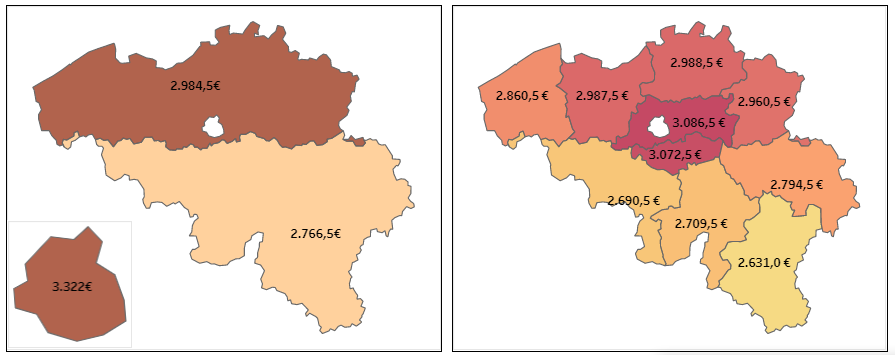New research has found regional differences in median salaries across Belgium, with the highest median salaries for full-time blue-collar workers found in Limburg and the highest white-collar wages in Brussels.
Private sector employees in Flanders are earning a median of €2,985 gross per month, meaning half of them are earning more than that and half are earning less. In Wallonia, that figure is €2,766.
The numbers come from HR company SD Worx, which collected salary data from 400,000 full-time employed Belgians.
“A median salary gives a better idea of the 'average' salary,” explained Kim Van Houtven, SME consultant at SD Worx.
“Often employees mirror an amount too high, based on studies that work with unweighted averages. This gives us an unrealistic picture of what an employee sees gross on their payslip every month.”
Instead, SD Worx used actual wage data – “the largest sample in Belgium” – explaining that this method is “more reliable than questionnaires: otherwise, there can be a bias, depending on who answered.”
Differences in median salaries
“By 'gross monthly salary' we mean the monthly amount on the payslip, without end-of-year bonuses and holiday pay,” SD Worx clarified. “This amount does not take into account the additional salary elements, nor the costs of the employer.”
The figures do take into account the composition of the Belgian population by type of employment, gender, age, sector and company size.

Graphic from SD Worx.
While wages are said to be highest in Brussels (with Flemish and Walloon Brabant just behind), this is only the case for white-collar workers. For blue collar workers, the median wage is actually the lowest there.
Specific roles, age, sector and employment status will also cause pay to differ. “If you have an executive role, it is best to compare with similar profiles, preferably in the same sector and place of employment,” Van Houtven said.
The median gross wage for blue-collar workers increased during the first three months of 2022 to €2,672, a number that doesn’t include extras such as bonuses for night work or other sector benefits.
Employers must do more to attract top talent
Limburg has the highest median wage for blue-collar workers at €2,805, and employs a higher share of them than Brussels.
“For workers, it can be interesting to look at those regions with a lot of industry,” said Van Houtven.
“Employers in those regions would do well to extend their recruitment campaign beyond the border of the province – in this way they may be able to attract new people to their company, even though it will take them a little longer to commute.”
Related News
- Cost of living crisis: Families ditch farmers markets for supermarkets
- As customers pay more for groceries, discount grocer Lidl reaps rewards
Van Houtven also pointed out that the war for talent – which has led to employees having greater choice when it comes to whom they sell their labour – means companies need to keep their salaries competitive.
“Employers who want to pay in line with the market, for example to attract talent, often request benchmark studies – this ensures that their wages are in line with other employers in the region,” said Van Houtven.
“This exercise is more important than ever in the battle for talent. Recent research confirms that wages are still the first basic condition to ensure that employees do not leave or become dissatisfied.”

